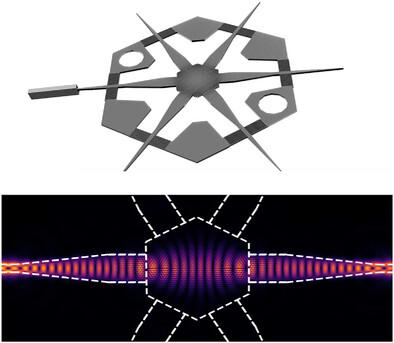Terahertz All‐Dielectric Maxwell Fisheye Lens Waveguide Crossings via Transformation Optics
IF 10
1区 物理与天体物理
Q1 OPTICS
引用次数: 0
Abstract
Terahertz waveguide crossings are critical for compact, integrated signal routing in monolithic platforms, but simple waveguide intersections suffer from high losses and crosstalk due to mode mismatch in the regions where the waveguide channels overlap. The Maxwell fisheye lens with its inherent imaging properties is an excellent solution for multichannel intersections, however, its circular shape is not easily integrated with common planar input/output waveguides. Here, all‐silicon waveguide crossings are introduced based on Maxwell fisheye lenses reshaped via conformal transformation optics for improved planar waveguide integration in the terahertz range. Using effective medium techniques with subwavelength air inclusions, and crossings operating over the 220–330 GHz frequency band are designed and fabricated. The transformed lenses enable aberration‐free imaging without mode mismatch, implemented through a single deep reactive ion etching step. Experimental characterization reveals average insertion loss of 1.2 dB and crosstalk below –50 dB for the fundamental quasi‐transverse electric (TE) mode, with a 40% bandwidth across the entire 220–330 GHz band, while the quasi‐transverse magnetic (TM) mode is also supported for dual‐polarization applications. The transformed lenses have a diameter of just 4 mm ( at 275 GHz), while the total device footprint including input and output tapers is . This approach is scalable to waveguide crossings, providing a broadband and compact solution for low‐loss terahertz integrated optics.

基于变换光学的太赫兹全介质麦克斯韦鱼眼透镜波导交叉
太赫兹波导交叉对于单片平台中紧凑、集成的信号路由至关重要,但简单的波导交叉由于波导通道重叠区域的模式不匹配而遭受高损耗和串扰。麦克斯韦鱼眼透镜以其固有的成像特性是多通道交叉的一个很好的解决方案,然而,它的圆形不容易与普通的平面输入/输出波导集成。本文介绍了基于共形变换光学整形的麦克斯韦鱼眼透镜的全硅波导交叉点,以改善太赫兹范围内的平面波导集成。采用有效的亚波长空气夹杂介质技术,设计和制造了220-330 GHz频段的交叉通道。转换后的透镜可实现无像差成像,无模式失配,通过单个深反应离子蚀刻步骤实现。实验特性表明,准横向电(TE)模式的平均插入损耗为1.2 dB,串扰低于-50 dB,整个220-330 GHz频段的带宽为40%,而准横向磁(TM)模式也支持双极化应用。转换后的透镜直径仅为4毫米(275 GHz),而包括输入和输出锥度在内的总器件占地面积为。这种方法可扩展到波导交叉,为低损耗太赫兹集成光学提供宽带和紧凑的解决方案。
本文章由计算机程序翻译,如有差异,请以英文原文为准。
求助全文
约1分钟内获得全文
求助全文
来源期刊
CiteScore
14.20
自引率
5.50%
发文量
314
审稿时长
2 months
期刊介绍:
Laser & Photonics Reviews is a reputable journal that publishes high-quality Reviews, original Research Articles, and Perspectives in the field of photonics and optics. It covers both theoretical and experimental aspects, including recent groundbreaking research, specific advancements, and innovative applications.
As evidence of its impact and recognition, Laser & Photonics Reviews boasts a remarkable 2022 Impact Factor of 11.0, according to the Journal Citation Reports from Clarivate Analytics (2023). Moreover, it holds impressive rankings in the InCites Journal Citation Reports: in 2021, it was ranked 6th out of 101 in the field of Optics, 15th out of 161 in Applied Physics, and 12th out of 69 in Condensed Matter Physics.
The journal uses the ISSN numbers 1863-8880 for print and 1863-8899 for online publications.

 求助内容:
求助内容: 应助结果提醒方式:
应助结果提醒方式:


